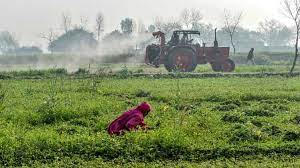TOKYO/ BUENOS AIRES/ LAHORE (Web Desk/Reuters): Japan’s weather bureau said on Monday that there was an 80 per cent chance that the El Nino phenomenon would end during the Northern Hemisphere spring, Reuters reported.
At the same time, the bureau also said there was a 40pc chance the La Nina weather pattern would occur during the summer.
Global warming or climate change is already adversely affecting Pakistan and the prevailing El Nino has severely impacted Pakistan in shape dry weather – one of the extreme weather events – although different parts of the country like Lahore during the monsoon season and Gwadar recently received record rainfall.
In fact, Lahore saw multiple days of record-breaking rainfall during the last monsoon but long gaps between these.
However, rainfall was much below the average in other parts of Pakistan during the same season, especially in northern and north-eastern Punjab [barring Lahore and surrounding areas] as well as upper Khyber Pakhtunkhwa and Kashmir which should be receiving most of the monsoon rains.
With an alarming inflation rate, any weather changes will have effects on Pakistan as the country must ensure food security for the people.
ARGENTINA FARMERS ARE WORRIED
Last week, Reuters had reported the Rosario grains exchange as saying that the high probability of a strong La Nina arriving by October has put grains farmers on alert in Argentina, where the climate phenomenon usually brings dry weather with lower rainfall.
Argentina is one of the world’s main grains exporters and dry conditions towards the end of the year would affect the development of part of the wheat crop and the planting of corn and soybeans in the next 2024-25 season.
“An analysis carried out with data from international organisations on the Pacific shows a clear trend: the 77pc possibility of a ‘La Nina’ event for the month of October,” the exchange said in a report. “The information is worrying.”
Argentina, where the 2023-24 campaign is currently under way, has only recently emerged from a string of three straight years of La Nina, which hit particularly hard the 2022-23 harvest, halving production of key soy, corn and wheat crops.
The exchange added that forecasts pointed to a strong version of the climate phenomenon.
“The level of cooling that is being projected has rarely been seen in the last 25 years,” it said, referring to an acceleration of equatorial trade winds associated with La Nina that cause a cooling of the Pacific at the Equator.
“To find a similar cooling we must go back to the end of 2007 and the beginning of 2008,” the exchange added. In the 2008/09 campaign, Argentina suffered a severe drought whose losses were similar to those seen last year.
Soy and corn in Argentina are currently in growth stages, having benefited from abundant rains as a result of the current El Nino phenomenon, the reverse of La Nina. The Rosario exchange estimates the 2023/24 soybean harvest at 49.5 million tons and the corn crop at 57 million tons.
DIFFERENCE BETWEEN EL NINO AND LA LINA
El Nino means “Little Boy” in Spanish. South American fishermen first noticed periods of unusually warm water in the Pacific Ocean in the 1600s. The full name they used was El Nino de Navidad, because El Nino typically peaks around December.
In the case of El Nino, the central and eastern tropical Pacific Ocean gets warmer. It is a natural event that occurs irregularly, typically every two to seven years, and can last from several months to over a year.
El Nino is part of a larger climate pattern known as the El Nino-Southern Oscillation (ENSO). During a typical El Nino event, the warm oceanic waters shift eastward towards Americas, altering the atmospheric circulation patterns in the region. This can have significant impacts on weather patterns around the world.
On the other hand, La Nina means “Little Girl” in Spanish, which is also sometimes called El Viejo, anti-El Nino, or simply “a cold event”.
La Nina has the opposite effect of El Nino. During La Nina events, trade winds are even stronger than usual, pushing more warm water toward Asia.
IMPACTS ON PAKISTAN
While El Nino is mostly associated with hot summers and lack of rainfall during monsoon season in South Asia, La Nina brings cooler temperatures and general increase in rainfall for the region.
So the question remains: When will La Lina return? Before the summer and monsoon this year or after that?
Pakistan must welcome an end to the El Nino phenomenon, as the prevailing cycle already witnessed variations in monsoon rainfall with below average rains, heatwaves, rising temperatures, glacial melt and intense rains [extreme weather event] locally.
But the arrival of La Lina will bring normal weather conditions and increase in rainfall after below average monsoon rains and extremely dry winter – which is now being replaced by intense and heavy rainfall in different parts of Balochistan, including Gwadar.







